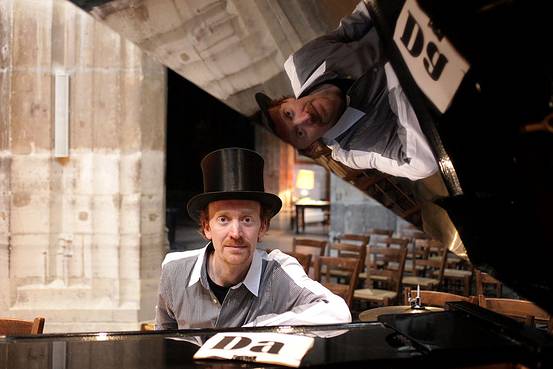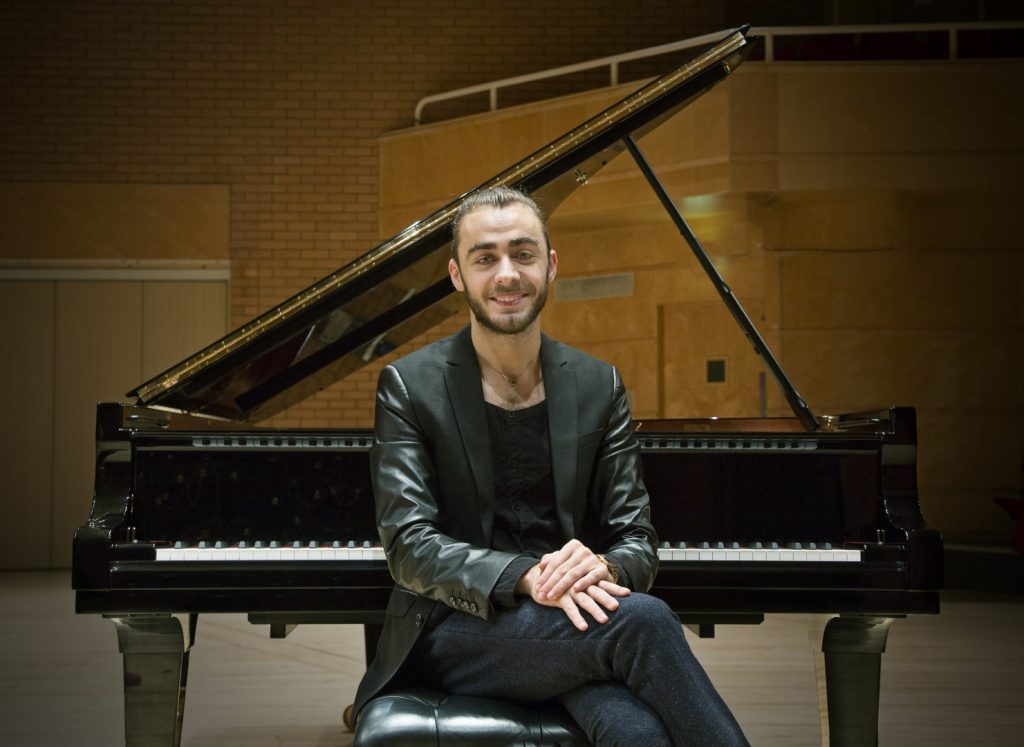Two pianists bring time and places to vibrant, anarchic life

Pianist Guy Livingston performed a multimedia program inspired by the Dada movement Wednesday night at Baruch College. Photo: Marilyn Smith
Classical music is a snapshot of culture, the notes and instructions that are printed on the page freezing the ideas and values of a time and place, waiting to be reconstituted by musicians.
Those slivers of culture should be revived in concert. Yet too often the experience is of placing things behind glass, as in a museum, so that one can’t get close.
This week two pianists brought times and places from the past to real, evanescent, life.
These were two very different concerts with equally different purposes and goals—on Wednesday Guy Livingston sought to recreate a specific moment in time, while young pianist Daniel Ciobanu channeled the spirits of specific places Thursday night.
At the Baruch Performing Arts Center, Livingston performed “Dada At The Movies,” an enjoyable bit of multi-media art history and anthropology. With some audience participation, he outlined the “Soirée couer à Barbe,” an event from July 8, 1923, that marked the end of the Dada movement, as the Surrealists angrily split from Tristan Tzara, Marcel Duchamp, Kurt Schwitters, et al. André Breton even mounted the stage and attacked some of the performers.
Dada music has long meant Erik Satie, who was Dada before the fact with his aesthetic of serious absurdity. Livingston played the “Entr’acte” from Relâche to accompany Francis Picabia’s film Entr’acte, something of the last word in Dada.
The bulk of the evenig’s music, though, came from George Antheil.
Antheil is a fascinating and ambiguous figure, a quasi-dilettante who was often too self-conscious about being an avant-gardist, but made some good old-fashioned tonal American music (and in one of those oddities of history, collaborated with actress Hedy Lamarr to invent a radio guidance system for allied torpedoes in WWI).
Livingston is a strong advocate for the composer, with a fine album of Antheil’s piano music on the Wergo label. He played the Airplane Sonata, Little Shimmy, and Jazz Sonata as stand-along works.
These were smooth and jaunty performances with that specific Antheil sound that, more than any other music, captures the irreverence and promise that briefly thrived—as in Dada—between the World Wars. Those were mere appetizers: the real Dada came through in his playing of Antheil’s and Satie’s music for wonderful short films from Man Ray, Hans Richter, and Antheil himself (the clichéd but charming Woman).
After the destruction of WWI, artists like Tzara and Schwitters didn’t remake language as the Modernists did; they turned language into absurdity. Livingston read Tzara and Francis Picabia’s nonsense Dada Manifesto and, with audience help, performed “A Dada Dictionary” and some of Schwitters’ Ursonate, the framework that truly put the music into the spirit of Dada.
Even more effective at recreating the 1923 experience were the films Entr’acte and Richter’s Ghosts before Breakfast. (Livingston accompanied the latter with two of William Bolcom’s Rags.) With imagery both random and insane, they made bizarre though coherent stories out of things like flying bowler hats and a runaway hearse being pulled by a camel. Entr’acte in particular brought substantial, bittersweet charm to the close of the evening, with its scenes of Duchamp and Ray playing chess on a roof, and Satie and Picabia loading and firing an artillery piece. More absurdity in general would be welcome nowadays, and not just in the concert hall.

Daniel Ciobanu
Daniel Ciobanu’s performance at Weill Recital Hall was decidedly more serious, though no less good- natured and humorous—and a complete thrill from start to finish. The pianist was the Silver Medalist in the 2017 Arthur Rubinstein International Piano Master Competition, and one wondered just what it took for Szymon Nehring to garner the gold.
Perhaps the difference was Ciobanu’s own irreverence—his website states “the mission is simple: a cocktail of serious classical music combined with the lollipops and fireworks of the piano repertoire.”
He opened with a high-energy bit, a “Bachannal” from an unnamed composer. Then, welcomely without intermission, he played Enescu’s Carillon Nocturne No. 7, from the composer’s Op. 18 Suite No. 3, Mussorsgky’s Pictures at an Exhibition, three Scriabin Op. 11 Preludes, and finished with Guido Agost’s arrangement of the last three movements of the Firebird Suite.
Ciobanu’s blinding technique alone made this an exciting experience, and his power, smooth and quick fingering, and precise delicacy supported deeply musical and expressive playing. He is the type of pianist who takes something loud and fast, like the “Infernal Dance” from the Firebird, and makes it louder and faster without losing any clarity or meaning. He also made the “Lullaby” from the ballet and “The Old Castle” from Pictures gentler and more dolorous yet without a hint of manner or sentimentality.
Ciobanu clearly loves the sound of a piano—striking chords, playing fast figures, and pedaling as a way to relish the ring and glow coming off the strings. And few pianists can make a Steinway sound as good as Ciobanu did Thursday night.
The repertoire he chose was itself a pleasure. Before he played, Ciobanu made some brief remarks about the music coming from the Carpathians and the Ukraine, and he emphasized the pure sound of places, the wonderful clash of ringing monastic bells in Enescu, the soulful mysticism of Scriabin, and Mussorgsky’s dazzling imagination of places and their images.
This all may seem perhaps overly serious for his stated values, but when he came out for the encore, Ciobanu said “Let’s play some jazz.” He sat down and ripped off a boogie-woogie that was part Conlon Nancarrow, part Art Tatum, and a hell of a lot of fun.



Posted Oct 22, 2018 at 9:16 am by iuliana ciugulea
Hello, I am so pleased of the words describing Daniel„s Ciobanu concert. There are not just words, but like Daniel„s concert there are feelings. And more interesting is that in the same chronical there were three romanians names. Tristan Tzara( cofounder of dadaism) ,Enescu and daniel Ciobanu. I am really proud and happy reading this chronical so professional and charismatic. TKS GG
Posted Nov 03, 2018 at 1:36 pm by Tony Currie
Daniel is – quite simply – one of the most wonderful pianists around. I have witnessed him play several times and he never, ever, fails to utterly beguile. I’ve been around the music world for a long, long time, and I’ve heard many fantastic pianists, but Daniel – well, he’s simply in a league of his own. And I share George Grella’s curiosity at what made him come second to Szymon Nehring!